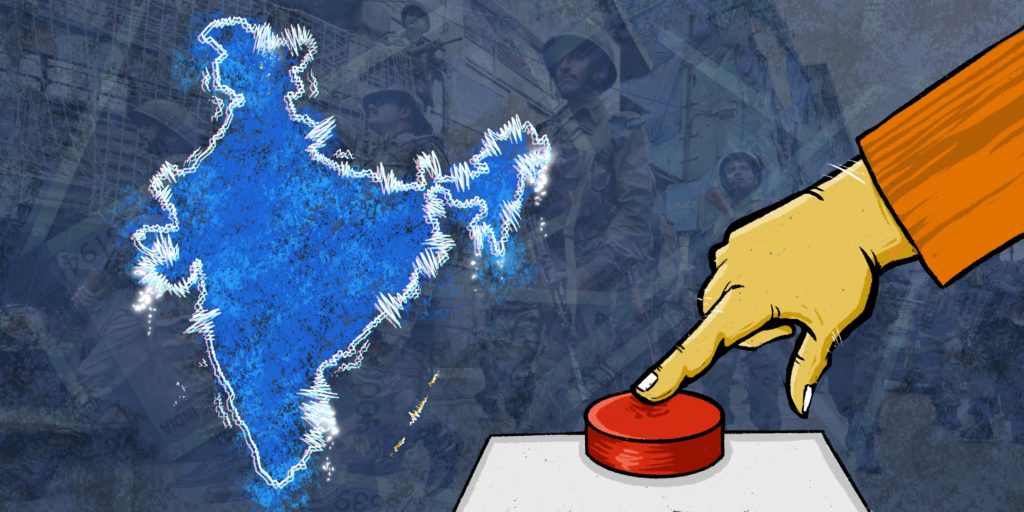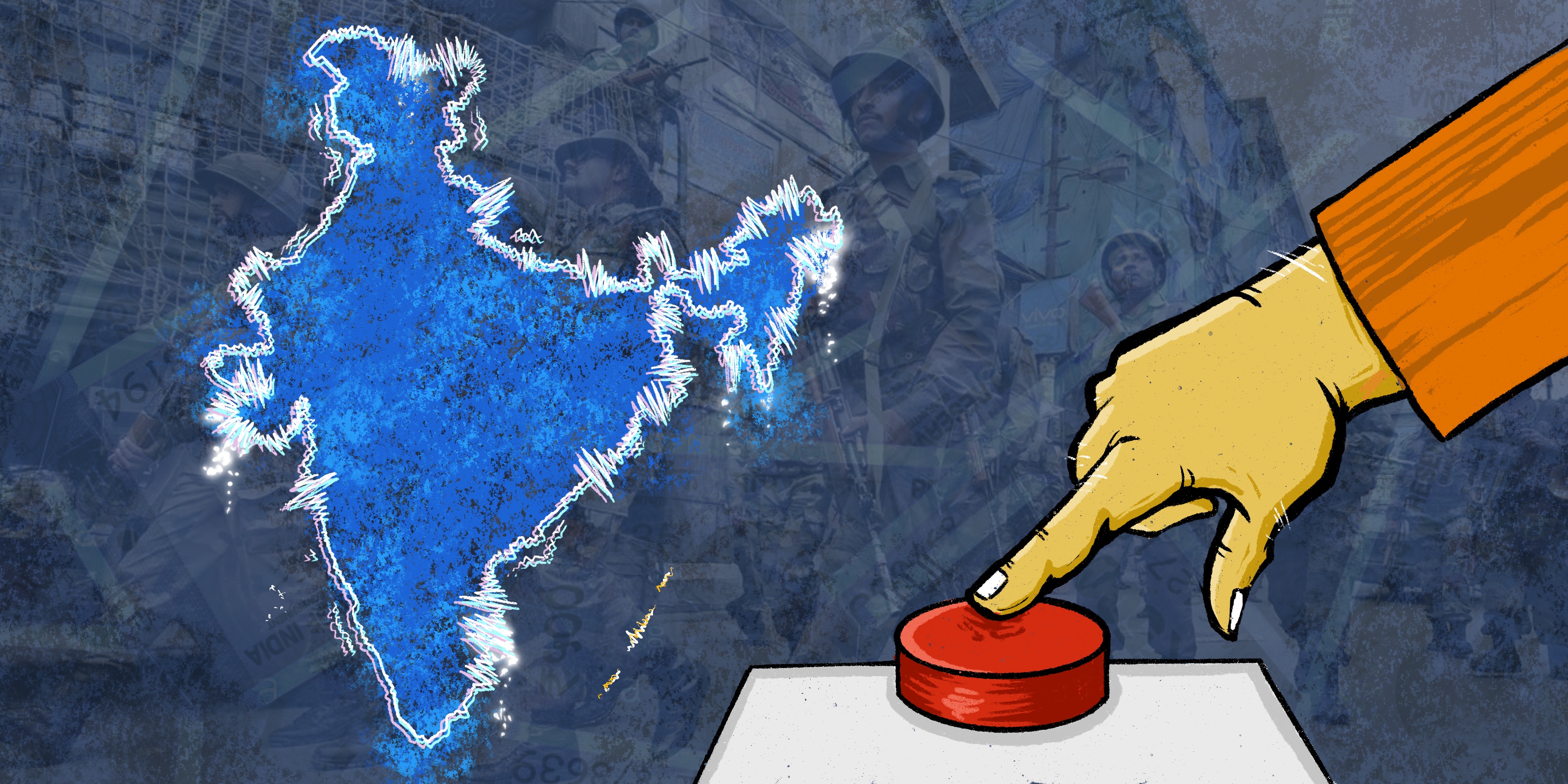

Modi’s lockdown follows a pattern of sudden and drastic policy changes he has brought in during his tenure that have come to be popularly termed ‘masterstrokes’ or ‘surgical strikes’. These ‘masterstrokes’ are a form of what Naomi Klein calls shock therapy i.e. a program of using shock and crisis to impose sweeping changes to society.

Modi’s latest ‘masterstroke’ has left many wondering what exactly he was thinking when he put India into the world’s largest lockdown overnight. Unlike other countries that have had to formulate emergency responses to the COVID-19 pandemic, Modi made no effort to implement phased social distancing policies and failed to even mention whether essential goods and services would remain available before imposing the lockdown, sending the world’s second largest population spinning into absolute panic and chaos. Modi also offered no economic relief before announcing the lockdown even though over 90% of India’s economy is constituted by a vast and variegated informal sector. This has left the large majority of India’s population literally out on the streets. Instead of making sure people would stay home, India’s lockdown has been forcing masses of migrant laborers to travel miles on foot to reach their homes and to congregate in shops to panic-buy essentials.
Is this a sign of Modi’s incompetence or foolhardiness, as some have argued?
Anyone observing Modi’s policies would be able to tell that masterstrokes like this are not an aberration for the Modi regime, but a norm. Since he came to power, he has become well known for his ‘bold’ moves. Modi has undertaken a series of such ‘surgical strikes’ as they have come to be popularly known. Modi’s many masterstrokes include taking more than half the country’s currency out of circulation in a surprise move, abrogating the constitutional privileges afforded to the state of Jammu and Kashmir overnight, imposing a Kafka-esque tax regime that sent India’s overwhelmingly informalized economy into shock, and passing a citizenship law that would create the largest statelessness crisis in the world. Don’t forget that the world has witnessed at least two anti-Muslim pogroms under his watch first as chief minister of the state of Gujarat and, just a couple of months ago in Delhi, as the country’s prime minister.
It would appear then that unleashing chaos, confusion, and terror characterizes the Modi regime’s tactics. As it happens, these are the same tactics that have been deployed across history to impose sweeping changes to political and economic regimes. Naomi Klein, author of the New York Time’s bestseller The Shock Doctrine: The Rise of Disaster Capitalism (2007), demonstrates that large-scale restructuring of society often follows crises or disasters. These can include economic shocks, for example, price shocks and commodity shocks. But they also include other forms of crisis. For example, the 9/11 terrorist attacks resulted in a transformation of U.S. foreign policy that allowed liberal market policies to be imposed in Iraq through military occupation. Natural disasters like the 2004 tsunami were used in Sri Lanka to undertake large-scale privatization along its coastline. Pinochet used a violent coup to introduce free-market reforms in Chile. Similarly, Klein continues, the famous Tiananmen massacre in China was used to convert parts of the country into controversial export zones.
The concept of shock treatment as a form of social engineering was formally developed by the free-market philosopher Milton Friedman. As an influential policy adviser to the Chilean dictator Augusto Pinochet, Friedman taught political leaders that shock, in the form of free-market economic policies, can be effectively utilized to create swift and sweeping changes that may have otherwise encountered resistance. These methods were inspired by techniques of psychological torture that were used to interrogate wartime prisoners. The belief was that by administering electric and other forms of psychological shock, one could coerce captives into giving up information that they wouldn’t otherwise reveal.
Why does crisis work? Naomi Klein suggests that unleashing chaos, confusion and fear can create a temporary suspension of the rule of law. When everyday life ceases to be normal, existing norms, rules and laws are also disrupted. As I will argue later, this can happen when state capacity is undermined, and state power becomes centralized. This can, in effect, result in a de facto state of emergency where whoever is calling the shots gets to exercise power unilaterally and make room for the large-scale restructuring of society. If shock therapy was used as an interrogation technique to shock prisoners into revealing information they would otherwise withhold, shock therapy is used by states during times of crisis to shock the polity into submitting to changes that they would not otherwise accept.
Modi’s doctrine of shock and awe
Instead, it has only compounded it by creating humanitarian and economic crises that demonstrate that Modi is primarily interested in orchestrating spectacles of shock and awe.While a force majeure is certainly the need of the hour in the midst of the global pandemic, the manner in which Modi implemented this lockdown took the country by surprise. Modi made an announcement at 8 pm on 24 March 2020 that India would effectively go into a complete lockdown by midnight. This not only threw the entire country into a sudden and total lockdown, but also left people in the lurch with no assured access to essential services. It also sent the country into panic and prompted large crowds to rush out to buy essentials. Two days prior to announcing the lockdown, Modi orchestrated a public spectacle calling on citizens to bang pots and pans to celebrate health officials. After a day of staying indoors on 22 March, crowds poured out onto the streets, taking out processions with pots and pans in the world’s most densely populated country. To date, the lockdown implemented by the government has done little to address the current public health crisis. Instead, it has only compounded it by creating humanitarian and economic crises that demonstrate that Modi is primarily interested in orchestrating spectacles of shock and awe.
While India is not the only country imposing a lockdown at this time, it is certainly one of the most brutal as it is enforced by a police state. In India the Police are seen beating hundreds in public, demanding bribes from small businesses, and even killing citizens just for trying to buy milk. Of the most horrifying scenes to emerge is one in which policemen force migrant laborers traveling hundreds of miles to reach home to crawl on the streets before of them.
A police state
India’s police state didn’t emerge only as a consequence of the lockdown. It has been in the making throughout Modi’s tenure as Prime Minister. As chief minister of Gujarat almost two decades ago, Modi has been widely accused of doing little to prevent and, worse, even complicity in, the mass murder of Muslims in 2002. More recently, police forces have been deployed across India to quell an outpouring of protest against the Modi government’s unconstitutional citizenship law. During this wave of protests across the country, the Delhi Police — which reports directly to the central government’s Ministry of Home Affairs — brutally attacked protestors and were even complicit in riots against the left-wing student union of Jawaharlal Nehru University (JNU). Following protests, police violence escalated into a full-blown pogrom against Muslims in New Delhi. The impunity with which the Police have been able to carry out such brutality has led to damning questions being raised against the powers that be, namely the Ministry of Home Affairs run by Amit Shah, Modi’s right-hand man since decades.
The impunity experienced by the Delhi Police has also corresponded with police forces in other states using increasingly heavy-handed tactics against protestors who were challenging the central government’s citizenship law. In other Bharatiya Janata Party (BJP) ruled states like Uttar Pradesh, the Police launched attacks against students of the Aligarh Muslim University (AMU) using military grade stun grenades and even attacked students while they were studying in libraries.
This is the same police force that is now being deployed to enforce Modi’s lockdown using incredible acts of brutality. Incidents that have been reported so far offer only a glimpse of what is yet to come: rather than supporting a lockdown in the interest of public health, Indian Police are dehumanizing and brutalizing citizens. In videos circulating online, the Police are seen making migrant workers perform squats and frog jumps on the streets. The Police have also disrupted essential services in this time of crisis by lathi-charging bank employees and delivery agents who are transporting medicine, food and milk. They have abused medical staff who are putting their own lives at risk in order to save the lives of others. They have beaten up senior citizens and detained 93 people in a move that defies any efforts towards social distancing. Moreover, their purported efforts to protect public health have also involved dehumanizing migrant workers by spraying them down with toxic chemicals under the pretext that this will ‘disinfect’ them.
Chaos and confusion
The lockdown has sent almost every aspect of life into complete chaos. It has prevented people with chronic illnesses from reaching healthcare providers; created a hunger crisis that has already taken, among many others, the life of an11 year old boy; disrupted the supply of essential medical goods; triggered a mass exodus of migrant workers, who are trying to reach their homes; left truckers carrying essential goods stranded; and resulted in farmers dumping producethat has become impossible to sell.
On 3 April 2020, less than a week after the beginning of the lockdown, Modi’s government attempted to use the chaos to dismantle democracy’s fourth pillar: the central government moved the Supreme Court in an attempt to impose a media gag. Luckily the government’s plea was not entertained; however, the government then proceeded to crackdown against dissenters by arresting human rights activists and students.
State capacity
Modi’s lockdown was not only imposed suddenly but was also accompanied by a hollowed-out State that had failed to establish safety nets for its vulnerable populations.While the media has portrayed China’s response as draconian and authoritarian, India’s ostensible democracy has also been oppressive and exploitative. There is therefore a need to assess success or failure as an outcome of the character of the state rather than through superficial assessments of regime types. India’s failure is rooted in Modi’s shock and awe style of an unplanned lockdown. Modi’s approach to the lockdown has been characterized as mere ineptitude, but this fails to appreciate how Modi’s response evinces a lack of state capacity that lends itself to these shock therapy style interventions. Modi’s lockdown was not only imposed suddenly but was also accompanied by a hollowed-out State that had failed to establish safety nets for its vulnerable populations. Together, these two factors have ensured that Modi’s regime has had its citizens living from one crisis to the next.
State capacity can be understood as the development of robust public institutions, the ability to discipline the private sector, to carry out state policies to achieve its desired ends, to allocate resources efficiently and to direct state efforts effectively. In terms of public health, state capacity would imply the ability to formulate a systematic and carefully considered response in a public health emergency. Other examples of state capacity include the capacity to implement large-scale testing, allocate funds for economic relief, discipline the private healthcare system so that it can meet the needs of the public health crisis, and direct private companies to manufacture necessary medical supplies.
India fares poorly on all these measures. Modi’s shock and awe style imposition of a lockdown seemed to catch even his own government by surprise. Following the announcement of the lockdown, Modi’s own Minister of Finance stated that she was formulating a quick ‘response’ to the situation betraying how deeply uncoordinated this program has been even within the government. Similarly, Modi’s recent spectacle wherein he ordered citizens to turn off the lights at 9 pm on 5 April, left even his own Ministry of Power scrambling to ensure that this would not result in a complete collapse of the grid.
Thus far, Indian healthcare workers have faced extreme shortages of Personal Protective Equipment (PPE) because the State allowed a procurement monopoly on supplies while also exporting the country’s stocks well after the World Health Organization had warned against it. India has thus far failed to direct private industry to manufacture PPEs, ventilators and medical equipment. The central government has failed to release funds to support the states’ efforts in dealing with the crisis and it has instead allocated funds to redevelop historic buildings in the capital city. The Indian government has also failed to ramp up testing capabilities despite public health officials emphasizing that testing is the cornerstone of any public health response. These actions effectively compromise state capacity while centralizing state power. We can think of state capacity as the ability of a system to carry out its stated aims or even as the presence of checks and balances that democratize and decentralize power. In the absence of these features, state power goes unchecked and becomes increasingly centralized.
The upshot of this is that India’s lockdown has essentially passed the costs of this response onto the poor. Nobel laureate Abhijit Banerjee, recently suggested that the Modi regime is welfarist. However, nothing is more telling of the absolute lack of social protections under the Modi regime than the suffering that India’s poor are undergoing at this time of crisis. The 2019-2020 budget saw deep cuts to social spending on healthcare. Modi’s politically expedient handouts have done nothing to create real safety nets that India’s poor can fall back on during this time of crisis. Instead, as if to turn tragedy into farce, Modi is now advertising a relief fund called PM CARES to solicit donations from the public even while it uses tax-payers money for beautification projects.
As the death toll increases, economists have argued that the economic collapse the country is about to see is unprecedented.
If Naomi Klein’s decades of research tell us anything, it is that in India’s case this crisis will be used to further Modi’s agenda by clamping down on dissent and establishing an increasingly draconian police state.





